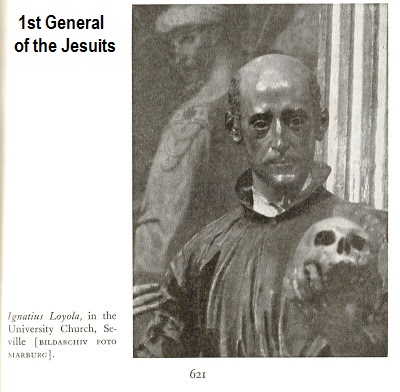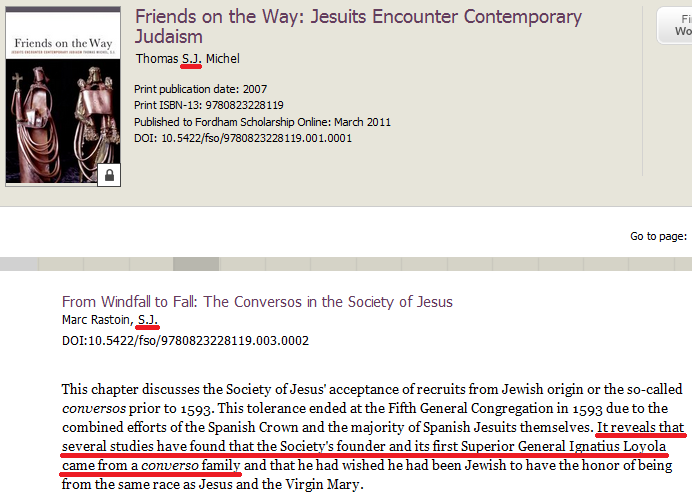- Mysticism in the Evangelical Church
- ‘Emerging Church & Catholic Mysticism’
- Mysticism- Ignatius of Loyola, Pt.1
- Mysticism- Ignatius of Loyola, Pt.2
- Mystic Teresa of Avila, Pt.1
- Mystic Teresa of Avila, Pt.2
- Biblical Meditation vs. Eastern Meditation
- Mystic Teresa of Avila, Pt.3
- Law of Attraction vs. The Bible
Most evangelicals would recognize & reject occult practices like mediums, the Ouija board, etc. knowing the Bible condemns and calls this an abomination. But sadly thousands without knowing are embracing occult practices by accepting mystical Spiritual Exercises. As an ex-Catholic it breaks my heart to see evangelicals following Catholic saints or their mystical teachings.
It is very important to examine what is the spirit behind any spiritual practice 1 John 4:1 before we open the door & welcome them 2 Jn.1:10. Some people will say that what they are learning is in the Bible, but beloved please remember satan is a master of deception! Always check who were the mentors of that teacher, or where their doctrine came from. One of the most used mystic exercises belongs to Jesuit founder Ignatius of Loyola.
Ignatius of Loyola, baptized Íñigo López, was a Catholic mystic. (23 October 1491 – 31 July 1556), was born in the Basque city of Loyola castile Spain. (Spain was heavily influenced by Jewish & Sufi Mysticism).
Loyola was beatified by the Catholic Church in 1609, and then canonized, receiving the title of Saint on 12 March 1622. His feast day is celebrated on 31 July. (On March 13th, 2013 Pope Francis became the first Pope that is a follower of Loyola).


Saint Ignatius medal
Mystics believe in salvation by works, also denying self pleasure & experiencing self-induced pain are consider spiritual merits to get closer to God. The starting point of mysticism is encountering God or ‘union with God’. Most ‘Christian’ mystics have believed in universal salvation & that “hell” is not endless. Their visions, impressions & imaginary conversations become their truth & reality, replacing sound doctrine. They make emphasis on personal experience over doctrine. All known ‘Christian Mystics’ of the past were Catholics. Also Gnostics, kabbalists, Sufis, etc. are mystics.
In his youth Loyola joined the army, he served under a relative, Antonio Manrique de Lara, duke of Nájera & he fought several battles without incidents, but on May 1521 in a battle in Pamplona he was hurt by a cannonball, breaking his right leg. He was transported to Loyola a month later. His bone in the broken leg was set incorrectly and his leg was rebroken and reset, he would then walk with a limp.
During his painful convalescence he read Catholic mystic books & he experienced a series of visions in full daylight. One of the books which most influenced him was the De Vita Christi (Life of Christ) of Ludolph of Saxony a German mystic monk. This book inspired him to follow the example of mystic Francis of Assisi & other Catholic monks. It is also said that inspired his method of meditation, since Ludolph proposes that the reader place himself mentally at the scene of the Gospel story, visualizing the crib at the Nativity, etc. This is known as Simple Contemplation, & was the basis for the method that St. Ignatius would promote in his Spiritual Exercises. e.g. self-projection into a Biblical scene to start a conversation with Christ in Calvary, etc. The methods of meditation in the Vita Christi entered Spain and were known in the early part of the 16th century, mystics St Teresa of Avila (her father & grandfather were conversos) & St. John of the Cross (converso) frequently quoted from Ludolph. Both are the founders of Discalced Carmelites.
After recovery Ignatius went in 1522 to Monserrat (Barcelona) & dedicated his life to the virgin “Our Lady of Montserrat“.

Black Madonna “Our Lady of Montserrat” at Monserrat mountain close to Barcelona (Spain). The site was before, a Roman temple to goddess Venus

Cave in Manresa, region of Catalonia, Spain.
He continue his journey to Manresa (Catalonia region), where he lived for 11 months in a cave wearing sackcloth, barefoot, doing contemplative prayer & penitence by practicing rigorous asceticism. In the Litany prayers to Saint Ignatius he is praised as being “constant in the practice of corporal penance.” There he had other visions e.g. of the Virgin Mary with infant Jesus, the Trinity, Virgin Mary alone, Peter, of a serpent shape object, etc.
These repetitive visions appeared as “a form in the air near him and this form gave him much consolation because it was exceedingly beautiful … it somehow seemed to have the shape of a serpent and had many things that shone like eyes, but were not eyes. He received much delight and consolation from gazing upon this object … but when the object vanished he became disconsolate.” –Jean Lacouture, Jesuits, A Multibiography, Washington, D.C.: Counterpoint, 1995, p. 18.
It was here where he wrote his Spiritual Exercises – (A 200-page set of meditations, prayers, & mental exercises to achieve spiritual illumination, very similar to the Meditations of Eastern Mysticism and Gnosticism. The exercises were designed to be carried out over a period of 28–30 days). While at Manresa he also grew to love the book ‘The Imitation of Christ‘, by mystic Thomas à Kempis, which arose from the Devotio Moderna movement. This book places emphasis on the devotion to the Eucharist as key element of spiritual life & it’s still used by Jesuits in their spiritual exercises. Recently Ignatian scholars had said that Ignatius was mainly influenced by some “Spiritual exercises” written by mystic Garcia de Cisneros of Montserrat, Spain .
After his experience in the cave he made a trip to Jerusalem. He returned to Spain where he did some studies in 1526 (The Reformation had started already with M. Luther in Germany around 1517-1521). With his companions he made some disciples of women while preaching. Three of these female disciples, Doña (Mrs) Leo, Doña Maria, and Doña Beatriz when Ignatius was preaching they started to experience ecstasies “one fell senseless, another sometimes rolled about on the ground, another had been seen in the grip of convulsions or shuddering and sweating in anguish.” Jesuits, A Multibiography by Jean Lacouture, pp. 27–29, Washington, D.C., 1995. -These manifestations had taken place while Ignatius and his companions were regularly preaching in public.
Widows Isabella Roser and Isabel de Josa, were wealthy Catalan women who were Loyola’s benefactors from the 1520s onward. Isabella demanded membership of the Jesuits for herself and two female companions, (she belonged to an exclusively female organization called “las Iñigas,” which was composed of devotees of Ignatius Loyola). Although this was initially granted it was rescinded in 1546 & the order has remained open only to males ever since.
It is believed that Loyola founded or became a member of the Alumbrados (a.k.a. Illuminati), a Gnostic sect composed mainly of kabbalist conversos, a.k.a. ‘marranos‘, but that as a cover for his activities he became very active as a Roman Catholic. In 1527 he was incarcerated 3 times by the Spanish Inquisition led by the Dominicans, under this same accusation, but was released with the help of pope Paul III/A. Farnese (Appointed by Pope Alexander VI/Rodrigo Borgia, as cardinal deacon, as a cardinal Farnese fathered 3 sons & 1 daughter).
Loyola moved to Paris Feb. 1528, where he studied at the ascetic Collège de Montaigu, where he remained for over 7 years. Collège de Montaigu, was an institution founded by important figures in the Devotio Moderna movement. There Ignatius gathered six faithful companions: Diego Laynez, a converso 21 years younger than Loyola (elected 2nd Superior General in 1558), Francis Xavier, Alfonso Salmeron & Nicholas Bobadilla, all Spanish; Peter Faber (converso), from France; & Simão Rodrigues (Jewish roots) from Portugal. Three others joined soon after — Claude Le Jay, a Genevan Savoyard; Jean Codure and Paschase Broët, French.
On August 15th of 1534 ( the day of “Assumption” of Mary), in the crypt of the Church of ‘Our Lady of the Martyrs‘, at Montmartre, (France) Loyola & the 9 companions made solemn vows over a skull & founded the Knights of the Virgin Mary (similar to the Knight Templars). They also vow to travel to the Holy Land.
In 1537 Ignatius formed the Society of Jesus, a military order & later gave himself to the service of the Catholic Church. The order was approved orally first in 1539, & solemnly confirmed in the bull ‘Regimini militantis ecclesiae’ Sept. 27, 1540 by Pope Paul III. Ignatius was then chosen as the first Superior General of the Jesuit order. On 22 April 1541, Ignatius and his first companions made their solemn vows as Jesuits before the image of Mary in the Basilica of St Paul Outside-the-Walls in Rome. The society played a big roll in the counter-Reformation and brought so much bloodshed, torture & suffering. Also they were part in the implementation of the II Vatican Council.
Loyola often ended his letters to Jesuits going to the missions with the expression “ite, inflammate omnia“ meaning, ‘go, set the world on fire‘.
The Duke of Gandia Francis Borgia traveled with the Jesuits to Rome to see Pope Paul III in 1537, but officially joined them in 1546 after his wife suddenly died (poisoned!). He was also of Jewish roots, & great-grandson of Pope Alexander VI. Through the influence of Borgia, Loyola obtained Paul III’s approval of the Spiritual Exercises (July 31, 1548). Years later (when Diego Laynez died) in 1565, Borgia was chosen as the 3rd Superior General.
Jews had lived in Spain since the 4th Century BC & prospered under the Moors who ruled Spain for 800 years. In late 14th Century, after Catholics took back Spain from the Moors, the Church demanded that the more than 400,000 Jews be converted to Catholicism or leave Spain. Because thousands had been massacred in the anti-Jews riots of 1348 & 1391, more than half of those Jews agreed to convert & became known as “conversos.” (same happened in Portugal). It is known that most conversions were done by necessity & not out of a real faith, so many Jews converted publicly to Catholicism but secretly they continued to practice Judaism, including following the Talmud & Kabbalah, that were popular in Spain among them.
The Inquisition was not directed against the Jews for practicing Torah Judaism, but for criminal activities connected with the Talmud and Cabala—even ritual human sacrifice and Tantric sex magick, for the Talmud directs Jews to exterminate Christians and the Cabala contains erotic elements. Watch-unto-prayer.org
It is believed that Ignatius & his companions were Kabbalistic Jews (Maybe not ethnic Jews but practicing the religion), & most of them were conversos a.k.a. “crypto-Jews” (or Marranos, a derogative term of those not sincere in their conversion). Loyola was born in 1491, from wealthy converso parents a year before the expulsion of the Jews from Spain in 1492. Check also.

A signed copy of the Edict of Expulsion, March 31st, 1492. See ‘Alhambra Decree‘.
Recent news Spain Expects up to 200,000 Jews to Apply for Citizenship. But we also can find some admissions made by several Jesuits & others writers, about Loyola and others of the Society’s founders.
Thomas Michel, S.J., is Secretary for Inter-religious Dialogue of the Society of Jesus (S.J.) in Rome and Ecumenical Secretary of the Fed. of Asian Bishops Conf. In his book he explores the role played in Jesuit history by Jews forced to convert to Christianity. Book published by Fordham University, a Jesuit institution. Find a review of the book here.
Continue. . . Pt.2
